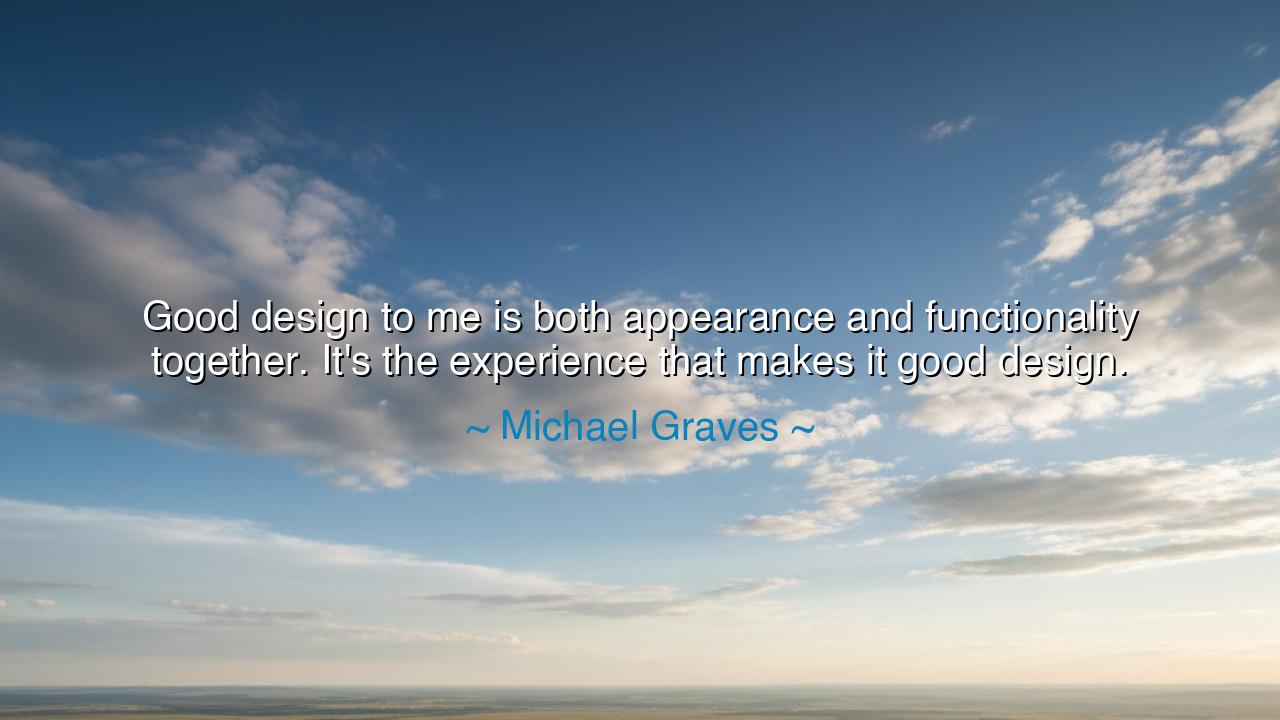
Good design to me is both appearance and functionality together.
Good design to me is both appearance and functionality together. It's the experience that makes it good design.






“Good design to me is both appearance and functionality together. It’s the experience that makes it good design.” – Michael Graves
In this profound reflection, Michael Graves, one of the great visionaries of modern architecture and product design, unveils the essence of true creation — that beauty and utility are not rivals, but partners in a sacred dance. His words remind us that design is not a matter of ornament or utility alone, but a union of both — a harmony where the eye is delighted and the hand is served. To Graves, good design is not just seen or used; it is felt. It moves through the senses like music — graceful, balanced, and complete.
To understand the depth of his wisdom, one must see that he speaks not merely of objects, but of life itself. For what is a well-lived life if not the perfect design — where appearance and purpose are joined, where beauty serves meaning, and function serves joy? Graves’ teaching reaches beyond the realm of architecture or craft; it reaches into the moral fabric of how we build our world. He reminds us that the things we create — our homes, our tools, our systems, our art — should not simply exist to perform a task, but to enrich the human spirit.
The origin of this truth lies deep in the tradition of those who built before us — the ancients who shaped temples, cities, and objects that spoke to both the hand and the soul. The Greeks called it symmetria, the balance of form and purpose; the Japanese named it shibui, the beauty of quiet perfection. The ancients knew what Graves reaffirms — that a thing without function is vanity, and a thing without beauty is lifeless. To design well is to create with compassion, to imagine not only how something looks, but how it is lived and loved.
Consider, for example, Graves’ own transformation after illness left him paralyzed. Confined to a wheelchair, he discovered that many tools of daily life — from hospital equipment to household furniture — were built without grace or empathy. They functioned, yes, but they did not care. From this revelation came his later designs — objects that merged utility with dignity: canes shaped to fit comfortably in the hand, hospital furniture that welcomed the patient with warmth, not cold sterility. Out of his suffering emerged a greater wisdom — that good design is human design, that it must serve not the machine, but the soul.
In this, he joins the lineage of creators who understood that experience is the final measure of excellence. A chair may stand upright, but if it invites no rest, it fails. A building may dazzle the skyline, but if it alienates the human spirit, it is hollow. Graves teaches us that every creation must speak to the senses and the heart alike. The experience of an object — how it feels to use, how it resonates in memory — is the invisible thread that binds beauty and function together. Without that unity, design becomes mere construction; with it, design becomes art.
This truth echoes far beyond the studio or workshop. In every life, we are all designers — of our days, our relationships, our surroundings. To live as Graves teaches is to craft our choices with both grace and purpose. Let your actions be beautiful in intention, but also functional in result. Let your work be pleasing to the eye, but also meaningful to the world. In all things, seek the experience that uplifts, that transforms, that endures. For it is not the surface of a thing that defines it, but how it touches those who encounter it.
Thus, the lesson stands: beauty and purpose are one. The path of mastery lies not in choosing between them, but in weaving them together. Whether you build a house, write a song, design a life, or heal a wound — make it both graceful and good, efficient and compassionate. Let your works carry not only the mark of skill, but the warmth of humanity. For when design becomes experience, when usefulness becomes joy, you will have created not just an object, but a legacy.
And so, as Graves reminds us, remember this truth in all your labors: to design well is to love well. It is to care for the eye, the hand, and the heart alike. It is to understand that what endures is not the shape of the thing, but the feeling it gives. Build, then, not for the moment — but for the soul. For only when appearance and functionality meet in harmony does design transcend craft and become life itself.






AAdministratorAdministrator
Welcome, honored guests. Please leave a comment, we will respond soon